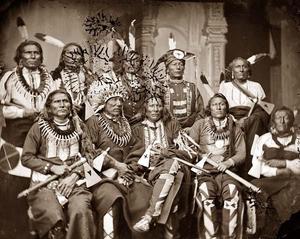Lionel Red Dog, one of Thomas King’s characters in his novel Green Grass, Running Water, was an employee of the government. He worked in Indian Affairs, and his job took him all over North America. It was in South Dakota that Lionel had his last assignment. Lionel was sent to Utah to deliver a speech on “The History of Cultural Pluralism in Canada’s Boarding Schools.” While there, he runs into a band of natives that coheres him into going to Wounded Knee for a peaceful rally.
Along the way, the vehicle that Lionel is riding in is pulled over by the police. He steps from the car, and trips over a gun that was  lying in the back. Hit by a policewoman, he is taken to jail and, while there, he loses his job. This, in a way, is very similar to what happened to AIM (American Indian Movement) some years back. The natives were upset about the Government’s neglect of treaties and grants. The natives held a peaceful rally in a town, then they all packed up, and moved it to Wounded Knee. Wounded Knee was the sight of a terrible massacre in the late 1800’s. The Natives were traveling to a neighboring camp, when soldiers came upon them, and “captured” the natives.
lying in the back. Hit by a policewoman, he is taken to jail and, while there, he loses his job. This, in a way, is very similar to what happened to AIM (American Indian Movement) some years back. The natives were upset about the Government’s neglect of treaties and grants. The natives held a peaceful rally in a town, then they all packed up, and moved it to Wounded Knee. Wounded Knee was the sight of a terrible massacre in the late 1800’s. The Natives were traveling to a neighboring camp, when soldiers came upon them, and “captured” the natives.
The natives were asked to give up all weapons, and a misunderstanding led the soldiers to believe there was a resistance. The soldiers opened fire on the Natives, and over three quarters of the natives were killed. There, at Wounded Knee, The natives set up road blocks meant to keep tourists out. They did this so that the government would take notice of their plight. But things went horribly wrong. The FBI intervened, and set up their own road blocks. They stopped all traffic and it soon became a standoff. The natives were confused that such an action should be taken, and many left. Of those who stayed, all were members of AIM. The FBI claimed that the AIM members were holding hostages, even though the hostages told the FBI that they stayed because that was their home. The whole thing escalated until the army was moved in.
Eventually, the FBI apprehended the members of AIM and the truth of the situation was suppressed for many years. The American Indian Movement lost much of it’s credibility and support. This all happened in 1973. If we were to look at the basic story line to Lionel’s history and the AIM occupation of Wounded Knee, we would see many similarities. The first similarity would be both Lionel’s and AIM’s reputations. Before the troubles for both of them, they had very good reputations. Lionel had a great job, AIM was well supported. Then they both went to a peaceful demonstration. Both demonstrations were about the same place, but at different times. AIM’s demonstration was about the land around Wounded Knee, and their rights, while Lionel went to a demonstration about what had happened at Wounded Knee. I think it is here that I should mention that both these things happened at different times. Lionel comes along after AIM, and it is a demonstration about what had happened to AIM that Lionel is going to attend.
Upon reaching the point where the demonstration is to be held, Lionel is stopped by the police, and because of a misunderstanding, he is taken to jail. AIM is also wrongly accused and is eventually arrested by the authorities. And the last, big similarity between Lionel, and AIM, is the loss of their credibility. Lionel has a hard time finding a job, and ends up working in an electronics store. AIM too, losses it’s credibility, and has not yet recovered completely from the actions it took, and the actions taken against it. I believe that Thomas King is quite clever in using Lionel to tell the story of the occupation of Wounded Knee by AIM. Thomas uses Lionel effectively as a tool, and anyone who has read, or has heard about what happened at Wounded Knee in 1973 would catch on quite quickly as to his intention of using Lionel for his telling of the happenings at Wounded Knee.
Bibliography
King, Thomas. Green Grass, Running Water. United States: HarperCollins, 1994. Zimmerman, Bill. Airlift to Wounded Knee. Chicago, Illinois: The Swallow Press Incorporated, 1976. Lyman, Stanley David. Wounded Knee 1973: A Personal Account. Ed. Floyd O’neil, June Lyman, and Susan McKay. Nebraska: University of Nebraska Press\Lincoln & London, 1991. Brown, Dee. Bury my Heart at Wounded Knee. United States: Holt, Rinehart and Winston, 1971. —. Wounded Knee. United States: Holt, Rinehart and Winston, 1974.
